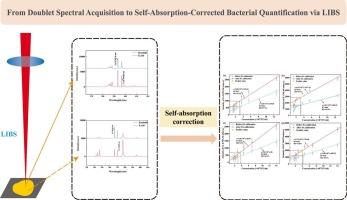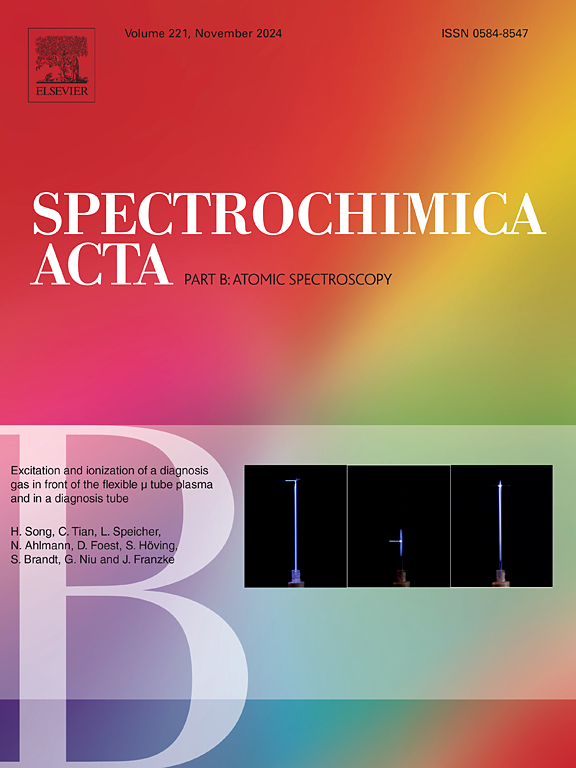双线自吸收校正法在细菌浓度定量中的应用
IF 3.8
2区 化学
Q1 SPECTROSCOPY
引用次数: 0
摘要
激光诱导击穿光谱(LIBS)因其快速、低破坏性和实时的元素分析能力而得到广泛认可。然而,细菌样品的复杂性和自吸收效应引起的光谱信号干扰对LIBS用于细菌浓度定量分析的准确性和可靠性提出了重大挑战。为了解决这些问题,本文提出了一种基于双线强度比和k参数比的自吸收校正方法,并首次成功应用于提高细菌浓度定量的准确性。通过优化激光参数,验证了细菌激光诱导等离子体满足局部热力学平衡(LTE)。选择具有相似或相同的上下能级(Ca II 393.36/396.84 nm, Ca I 612.22/616.22 nm和K I 766.49/769.90 nm)的特征双线,建立K参数比与自吸收系数(SA)的关联模型,实现有效的谱线自吸收校正。结果表明,经自吸收校正后,对大肠杆菌和枯草芽孢杆菌的定量分析误差显著降低,Ca II 393.36 nm的误差分别降低4.0%和11.6%,K I 766.49 nm的误差分别降低9.1%和6.9%,Ca I 612.22 nm的误差分别降低4.3%和3.9%。在107 ~ 108 CFU/mL的细菌浓度范围内实现准确定量。该校正方法简单、高效,不受复杂参数和外部条件的影响,显著提高了LIBS在细菌浓度分析中的精密度和重现性。此外,基于svm的5种细菌的分类准确率显著提高,提高了3.55%。其强大的通用性支持其扩展到其他微生物检测应用,提供快速,准确和具有成本效益的方法。这些发现为LIBS在生物监测中的广泛应用奠定了坚实的基础,在环境监测、食品安全和公共卫生诊断方面具有广阔的应用前景。本文章由计算机程序翻译,如有差异,请以英文原文为准。

Doublet line ratio-based self-absorption correction in LIBS applied to bacterial concentration quantification
Laser-induced breakdown spectroscopy (LIBS) is widely recognized for its rapid, low-destructive, and real-time elemental analysis capabilities. However, the complexity of bacterial samples and spectral signal interference caused by self-absorption effects present significant challenges to the accuracy and reliability of LIBS for quantitative bacterial concentration analysis. To address these challenges, a novel self-absorption correction method based on doublet line intensity ratios and K-parameter ratios is proposed and, for the first time, successfully applied to improve the accuracy of bacterial concentration quantification. Laser parameters were optimized to verify that the bacterial laser-induced plasma satisfies local thermodynamic equilibrium (LTE). Characteristic doublet lines sharing similar or identical upper and/or lower energy levels (Ca II 393.36/396.84 nm, Ca I 612.22/616.22 nm, and K I 766.49/769.90 nm) were selected to develop a model correlating the K-parameter ratio with the self-absorption coefficient (SA), enabling effective spectral line self-absorption correction. The results show that after self-absorption correction, the quantitative analysis errors were significantly reduced: for Escherichia coli and Bacillus subtilis, the errors decreased by 4.0 % and 11.6 % using Ca II 393.36 nm, 9.1 % and 6.9 % using K I 766.49 nm, and 4.3 % and 3.9 % using Ca I 612.22 nm, respectively. Accurate quantification was achieved within the bacterial concentration range of 107 to 108 CFU/mL. This correction method is straightforward, efficient, and independent of complex parameters or external conditions, significantly improving the precision and reproducibility of LIBS in bacterial concentration analysis. Additionally, the SVM-based classification accuracy for the five bacterial species improved markedly, rising by 3.55 %. Its robust generalizability supports its extension to other microbial detection applications, providing a rapid, accurate, and cost-effective approach. These findings lay a solid foundation for broader LIBS applications in biological monitoring, with promising potential in environmental surveillance, food safety, and public health diagnostics.
求助全文
通过发布文献求助,成功后即可免费获取论文全文。
去求助
来源期刊
CiteScore
6.10
自引率
12.10%
发文量
173
审稿时长
81 days
期刊介绍:
Spectrochimica Acta Part B: Atomic Spectroscopy, is intended for the rapid publication of both original work and reviews in the following fields:
Atomic Emission (AES), Atomic Absorption (AAS) and Atomic Fluorescence (AFS) spectroscopy;
Mass Spectrometry (MS) for inorganic analysis covering Spark Source (SS-MS), Inductively Coupled Plasma (ICP-MS), Glow Discharge (GD-MS), and Secondary Ion Mass Spectrometry (SIMS).
Laser induced atomic spectroscopy for inorganic analysis, including non-linear optical laser spectroscopy, covering Laser Enhanced Ionization (LEI), Laser Induced Fluorescence (LIF), Resonance Ionization Spectroscopy (RIS) and Resonance Ionization Mass Spectrometry (RIMS); Laser Induced Breakdown Spectroscopy (LIBS); Cavity Ringdown Spectroscopy (CRDS), Laser Ablation Inductively Coupled Plasma Atomic Emission Spectroscopy (LA-ICP-AES) and Laser Ablation Inductively Coupled Plasma Mass Spectrometry (LA-ICP-MS).
X-ray spectrometry, X-ray Optics and Microanalysis, including X-ray fluorescence spectrometry (XRF) and related techniques, in particular Total-reflection X-ray Fluorescence Spectrometry (TXRF), and Synchrotron Radiation-excited Total reflection XRF (SR-TXRF).
Manuscripts dealing with (i) fundamentals, (ii) methodology development, (iii)instrumentation, and (iv) applications, can be submitted for publication.

 求助内容:
求助内容: 应助结果提醒方式:
应助结果提醒方式:


